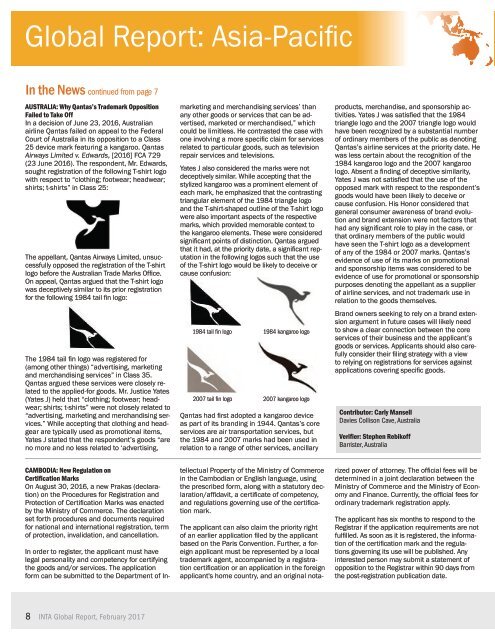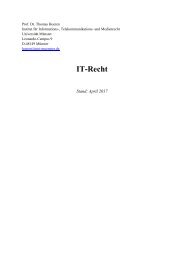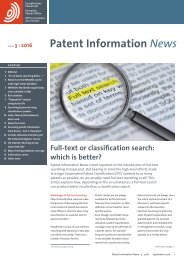GlobalReport
QqMg309yB9H
QqMg309yB9H
You also want an ePaper? Increase the reach of your titles
YUMPU automatically turns print PDFs into web optimized ePapers that Google loves.
Global Report: Asia-Pacific<br />
In the News continued from page 7<br />
AUSTRALIA: Why Qantas’s Trademark Opposition<br />
Failed to Take Off<br />
In a decision of June 23, 2016, Australian<br />
airline Qantas failed on appeal to the Federal<br />
Court of Australia in its opposition to a Class<br />
25 device mark featuring a kangaroo. Qantas<br />
Airways Limited v. Edwards, [2016] FCA 729<br />
(23 June 2016). The respondent, Mr. Edwards,<br />
sought registration of the following T-shirt logo<br />
with respect to “clothing; footwear; headwear;<br />
shirts; t-shirts” in Class 25:<br />
The appellant, Qantas Airways Limited, unsuccessfully<br />
opposed the registration of the T-shirt<br />
logo before the Australian Trade Marks Office.<br />
On appeal, Qantas argued that the T-shirt logo<br />
was deceptively similar to its prior registration<br />
for the following 1984 tail fin logo:<br />
The 1984 tail fin logo was registered for<br />
(among other things) “advertising, marketing<br />
and merchandising services” in Class 35.<br />
Qantas argued these services were closely related<br />
to the applied-for goods. Mr. Justice Yates<br />
(Yates J) held that “clothing; footwear; headwear;<br />
shirts; t-shirts” were not closely related to<br />
“advertising, marketing and merchandising services.”<br />
While accepting that clothing and headgear<br />
are typically used as promotional items,<br />
Yates J stated that the respondent’s goods “are<br />
no more and no less related to ‘advertising,<br />
marketing and merchandising services’ than<br />
any other goods or services that can be advertised,<br />
marketed or merchandised,” which<br />
could be limitless. He contrasted the case with<br />
one involving a more specific claim for services<br />
related to particular goods, such as television<br />
repair services and televisions.<br />
Yates J also considered the marks were not<br />
deceptively similar. While accepting that the<br />
stylized kangaroo was a prominent element of<br />
each mark, he emphasized that the contrasting<br />
triangular element of the 1984 triangle logo<br />
and the T-shirt-shaped outline of the T-shirt logo<br />
were also important aspects of the respective<br />
marks, which provided memorable context to<br />
the kangaroo elements. These were considered<br />
significant points of distinction. Qantas argued<br />
that it had, at the priority date, a significant reputation<br />
in the following logos such that the use<br />
of the T-shirt logo would be likely to deceive or<br />
cause confusion:<br />
1984 tail fin logo 1984 kangaroo logo<br />
2007 tail fin logo 2007 kangaroo logo<br />
Qantas had first adopted a kangaroo device<br />
as part of its branding in 1944. Qantas’s core<br />
services are air transportation services, but<br />
the 1984 and 2007 marks had been used in<br />
relation to a range of other services, ancillary<br />
products, merchandise, and sponsorship activities.<br />
Yates J was satisfied that the 1984<br />
triangle logo and the 2007 triangle logo would<br />
have been recognized by a substantial number<br />
of ordinary members of the public as denoting<br />
Qantas’s airline services at the priority date. He<br />
was less certain about the recognition of the<br />
1984 kangaroo logo and the 2007 kangaroo<br />
logo. Absent a finding of deceptive similarity,<br />
Yates J was not satisfied that the use of the<br />
opposed mark with respect to the respondent’s<br />
goods would have been likely to deceive or<br />
cause confusion. His Honor considered that<br />
general consumer awareness of brand evolution<br />
and brand extension were not factors that<br />
had any significant role to play in the case, or<br />
that ordinary members of the public would<br />
have seen the T-shirt logo as a development<br />
of any of the 1984 or 2007 marks. Qantas’s<br />
evidence of use of its marks on promotional<br />
and sponsorship items was considered to be<br />
evidence of use for promotional or sponsorship<br />
purposes denoting the appellant as a supplier<br />
of airline services, and not trademark use in<br />
relation to the goods themselves.<br />
Brand owners seeking to rely on a brand extension<br />
argument in future cases will likely need<br />
to show a clear connection between the core<br />
services of their business and the applicant’s<br />
goods or services. Applicants should also carefully<br />
consider their filing strategy with a view<br />
to relying on registrations for services against<br />
applications covering specific goods.<br />
Contributor: Carly Mansell<br />
Davies Collison Cave, Australia<br />
Verifier: Stephen Rebikoff<br />
Barrister, Australia<br />
CAMBODIA: New Regulation on<br />
Certification Marks<br />
On August 30, 2016, a new Prakas (declaration)<br />
on the Procedures for Registration and<br />
Protection of Certification Marks was enacted<br />
by the Ministry of Commerce. The declaration<br />
set forth procedures and documents required<br />
for national and international registration, term<br />
of protection, invalidation, and cancellation.<br />
In order to register, the applicant must have<br />
legal personality and competency for certifying<br />
the goods and/or services. The application<br />
form can be submitted to the Department of Intellectual<br />
Property of the Ministry of Commerce<br />
in the Cambodian or English language, using<br />
the prescribed form, along with a statutory declaration/affidavit,<br />
a certificate of competency,<br />
and regulations governing use of the certification<br />
mark.<br />
The applicant can also claim the priority right<br />
of an earlier application filed by the applicant<br />
based on the Paris Convention. Further, a foreign<br />
applicant must be represented by a local<br />
trademark agent, accompanied by a registration<br />
certification or an application in the foreign<br />
applicant's home country, and an original notarized<br />
power of attorney. The official fees will be<br />
determined in a joint declaration between the<br />
Ministry of Commerce and the Ministry of Economy<br />
and Finance. Currently, the official fees for<br />
ordinary trademark registration apply.<br />
The applicant has six months to respond to the<br />
Registrar if the application requirements are not<br />
fulfilled. As soon as it is registered, the information<br />
of the certification mark and the regulations<br />
governing its use will be published. Any<br />
interested person may submit a statement of<br />
opposition to the Registrar within 90 days from<br />
the post-registration publication date.<br />
8<br />
INTA Global Report, February 2017





